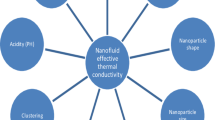Abstract
Low thermal conductivity is a primary limitation in the development of energy-efficient heat transfer fluids required in many industrial applications. To overcome this limitation, a new class of heat transfer fluids is being developed by suspending nanocry stalline particles in liquids such as water or oil. The resulting “nanofluids” possess extremely high thermal conductivities compared to the liquids without dispersed nanocrystalline particles. For example, 5 volume % of nanocrystalline copper oxide particles suspended in water results in an improvement in thermal conductivity of almost 60% compared to water without nanoparticles. Excellent suspension properties are also observed, with no significant settling of nanocrystalline oxide particles occurring in stationary fluids over time periods longer than several days. Direct evaporation of Cu nano-particles into pump oil results in similar improvements in thermal conductivity compared to oxide-in-water systems, but importantly, requires far smaller concentrations of dispersed nanocrystalline powder.
Similar content being viewed by others
References
J.C. Maxwell, A Treatise on Electricity and Magnetism, 2nd Ed., 1, 435, Clarendon Press (1881).
R.L. Hamilton and O.K. Crosser, I and EC Fundamentals, 1, no. 3, 187 (1962).
U.S. Choi, in Developments and Applications of Non-Newtonian Flows, eds. D.A. Signier and H.P. Wang, (American Society of Mechanical Engineers, New York), Vol. 231/MD-Vol. 66, 99 (1995).
C. G. Granqvist and R.A. Buhrman, J. Appl. Phys., 47, 2200 (1976).
Nanophase Technologies Corporation, Burr Ridge, IL
S. Yatsuya, Y. Tsukasaki, K. Mihama, and R. Uyeda, J. Cryst. Growth, 43, 490 (1978).
M. Wagener and B. Günther, these proceedings.
HE-200, produced by Leybold-Heraeus Vacuum Products Inc., Export, PA Duo-Seal #1407K-11, produced by Welch Vacuum Technology Inc., Skokie, IL.
J.A. Eastman, L.J. Thompson, and D.J. Marshall, Nanostruct. Mater. 2, 377 (1993).
Acknowledgement
This work was supported by the U.S. Department of Energy, BES-Materials Science, under Contract W-31-109-Eng-38 and by a grant from Argonne’s Coordinating Council for Science and Technology. We thank Carl Youngdahl for the micrograph of nanocrystalline Cu shown in Fig. 3(a).
Author information
Authors and Affiliations
Corresponding author
Rights and permissions
About this article
Cite this article
Eastman, J.A., Choi, U.S., Li, S. et al. Enhanced Thermal Conductivity through the Development of Nanofluids. MRS Online Proceedings Library 457, 3–11 (1996). https://doi.org/10.1557/PROC-457-3
Published:
Issue Date:
DOI: https://doi.org/10.1557/PROC-457-3




